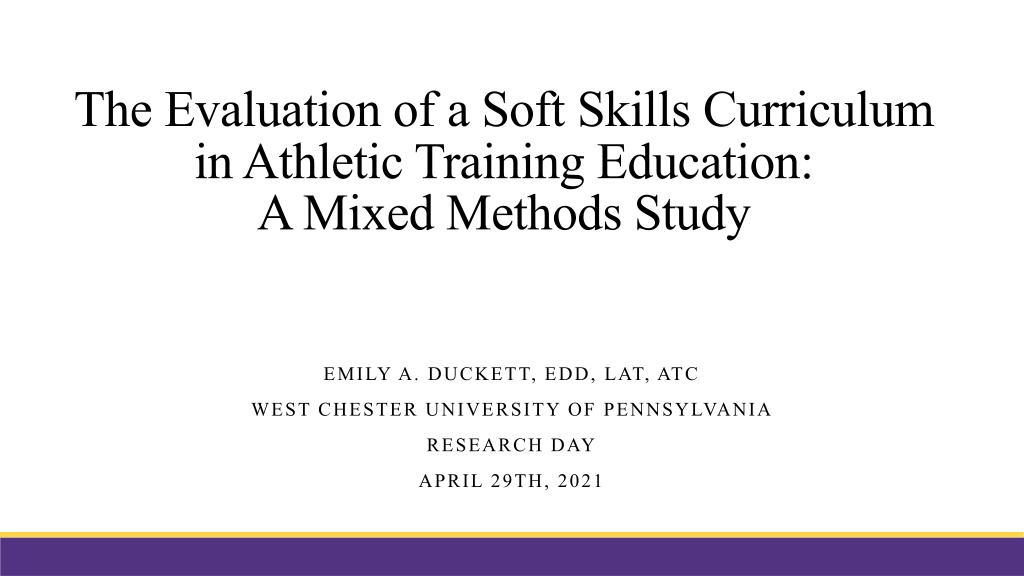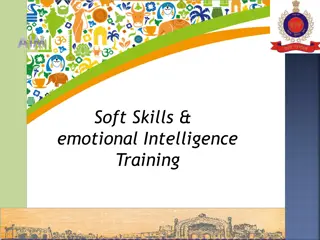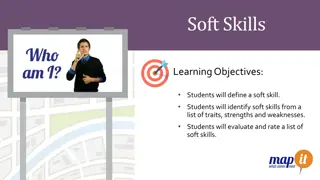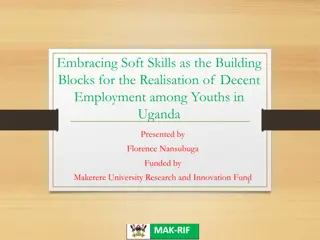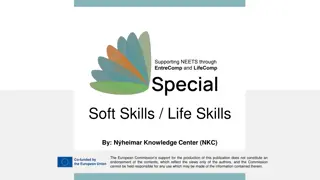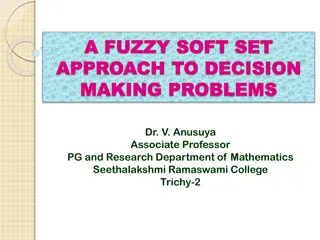Evaluation of Soft Skills Curriculum in Athletic Training Education
This study evaluates the effectiveness of a soft skills curriculum in athletic training education, focusing on pre-professional students' transfer of knowledge to clinical practice. It examines the significance of empathy and compassion in healthcare, along with the benefits they offer to patient outcomes. The purpose is to enhance foundational behaviors for quality patient-centered care. The study uses a mixed methods approach to explore both quantitative and qualitative results, discussing the implications of the findings on professional practice.
Download Presentation

Please find below an Image/Link to download the presentation.
The content on the website is provided AS IS for your information and personal use only. It may not be sold, licensed, or shared on other websites without obtaining consent from the author. Download presentation by click this link. If you encounter any issues during the download, it is possible that the publisher has removed the file from their server.
E N D
Presentation Transcript
The Evaluation of a Soft Skills Curriculum in Athletic Training Education: A Mixed Methods Study EMILY A. DUCKETT, EDD, LAT, ATC WEST CHESTER UNIVERSITY OF PENNSYLVANIA RESEARCH DAY APRIL 29TH, 2021
Objectives Introduction Purpose Research Questions Methodology Participants Description of Setting Procedures Instruments Results Quantitative Results Qualitative Results Discussion Discussion of Results Implications
Introduction In healthcare, soft skills include: ethics, attitudes, interpersonal abilities, communication, and lifelong learning (Joubert et al., 2006). Pre-professional healthcare students should have the opportunity to learn and practice soft skills to build foundational behaviors of professional practice prior to clinical experience. A top priority of healthcare is quality patient-centered care Foundational behaviors of professional practice (National Athletic Trainers Association, 2011)
Empathy & Compassion EMPATHY COMPASSION (Patel et al., 2019; Trzeciak & Mazzarelli, 2019)
Benefits of Empathy & Compassion in Healthcare patient compliance (DiMatteo et al., 1993) More accurate prognosis (Dubnicki, 1977) patient satisfaction (Zachariae, 2003) anxiety, depression and hostility in cancer patients (LaMonica, 1987) Optimal physiological outcomes in diabetic patients (Hojat, 2011) Improved patient adherence, satisfaction and treatment outcomes (Rattka, 2018) Activation of the parasympathic nervous system (Trzeciak & Mazzarelli, 2019) Psychological health benefits: trust building and cultivating hope (Trzeciak & Mazzarelli, 2019) Scientific evidence to support the effects of compassion on provider well-being, employee engagement, and organizational performance 1. 2. 3. 4. 5. 6. 7. 8. 9.
Purpose of Study The purpose of this study was to investigate the ways in which pre- professional athletic training students transfer knowledge from a soft skills curriculum during a didactic preprofessional course to clinical practice during their clinical experience. ?
Research Questions Q U A L [ q u a l ] 1.How do athletic training students describe their emotional response to utilizing soft skills during clinical practice? 1. How does a pre-professional soft skills curriculum associate with students development of empathy? 1.In what ways do athletic training students perceive they transferred soft skills into clinical practice? 2.In what ways are the development of soft skills associated with athletic training students subjective well-being? q u a n 2. How does a pre-professional soft skills curriculum associate with students development of compassion? 2. In what ways are the development of soft skills associated with athletic training students subjective well-being?
Surveys: Phase One Jefferson Empathy Scale for Health Professions Students (JSE-HPS) Compassion Scale (CS)
Reflection Logs: Phase Two 1. Empathy is defined by Patel (2019) as, the ability to sense, feel, and understand another s emotions. Given that definition, describe one or more times when you demonstrated empathy during the past two weeks of your clinical experience. 2. Compassion is defined as an emotional response to another s pain or suffering involving an authentic desire to help (Patel, 2019). Given that definition, describe one or more times when you demonstrated compassion during the past two weeks of your clinical experience. 3. Given the pandemic, in what ways has your ability to provide patient centered care been influenced in the last two weeks? Please describe your own well-being in the past two weeks. 4. 5. Describe the ways in which your own well-being has influenced your ability to exhibit soft skills and provide patient centered care in the last two weeks of your clinical experience. How frequently did you utilize the soft skills of empathy and compassion in the last two weeks? 6.
Semi-Structured Interview: Phase Two Embedded 1. Can you describe in your own words the definition of empathy? 2. Can you describe in your own words the definition of compassion? 3. Did [this class], specifically the lessons on compassion and empathy, influence you clinically? If so, in what ways? If not, why do you think this was the case for you? 4. Talk to me about your clinical site. What does empathy and compassion look like at your clinical site? Can you talk to me about a time when you demonstrated empathy/compassion at your clinical site? Can you talk to be about a time when you observed your preceptor demonstrate empathy/compassion at your clinical site? 5. Do you think your own well-being is associated with the delivery of compassion and empathetic patient centered care? If so, how? If not, why not? 6. Given the pandemic can you talk to me about providing patient centered care during this time?
Data Analysis Quantitative Repeated measure ANOVA with composite scores Qualitative Constant comparative method of analysis Thematic coding of reflection logs and semi-structured interviews
Quantitative Results: Student Empathy Development During an Academic Semester
Quantitative Results: Student Compassion Development During an Academic Semester
Qualitative Results: Perceived Application of Soft Skills
Qualitative Results: Curriculum to Clinical Practice Class Activities: Practice Discussing Emotions Self-awareness Clinical Experience: Mentorship Patient- Centered Care
Qualitative Results: Patient-Centered Care During a Pandemic Policy Changes Challenges Altruism communication challenging Face masks made Schedules Appointments more understanding when interacting with their patients in order to provide patient-centered care (Participant 1) Due to the pandemic, I feel as though we are able to give better patient- centered care than before (from what I can imagine). Many of these are one-on- one sessions and there is more time to get to know the athlete as an individual and how these injuries are affecting their lives (Participant 5). Needed to rely on body language and non-verbal communication We are all in this together and everyone s situation is different, so it s even more important to be considerate and kind in your care for others (Participant 19).
Qualitative Results: Students Subjective Well-Being
Qualitative Results: Emotional Response During Patient Care Subjective Well-Being Emotional Response During Patient Care Example My own well-being has been absolutely taken away from my ability to care for others. I am riding the [struggle] bus this week and it is very hard for me to be my best, kindest, and most compassionate self when it feels like every aspect of my life is a stressor (Participant 16). Negative Emotions Personal barriers that negatively impacted students ability to build therapeutic relationships I am very aware that I m in a dumpy mood if I m at my clinical site and I am evaluating someone you kind of flip that switch so you take on a different role as soon as the patient is gone or I m done providing care in that instance I can very easily go back to my mood. I know how I would want to be treated and how I would want to be as a clinician, so I think having that goal of who I want to be as an athletic trainer that is what reminds me to flip the switch (Participant 19). Neutral Emotions Flip the Switch a phenomenon where despite mood a sense of purpose to be fully present to help support a patient is practiced I have been making sure to take breaks and focus on me, my mental health, and well-being because I am of no use to my athletes if I am overwhelmed (Participant 13). Positive Emotions Positive emotions that influence partnership and reciprocity therapeutic relationships
Curriculum Activities and Clinical Experiences AT Students Perceived Application of Soft Skills Discussion of Results Students Subjective Well-Being and Emotional Response to Utilizing Soft Skills How the Global Pandemic Influenced Patient- Centered Care
Research Take Home Points 1. How is a pre-professional soft skills curriculum associated with students development of empathy? Statistically significant findings support students development of empathy F(2)= 20.38, p=.000 2. How is a pre-professional soft skills curriculum associated with students development of compassion? Data analysis did not reveal statistical significance for students development of compassion F(2)= 1.39, p=.261 3. In what ways do athletic training students perceive they transferred soft skills into clinical practice? Empathy: Relating to patients through lived experiences and staying out of judgement Compassion: Demonstrating helping behaviors of creating a plan of action or providing reassurance 4. In what ways are the development of soft skills associated with athletic training students subjective well-being? Students reported subjective well-being mirrored their emotional response to utilizing soft skills during clinical practice 5. How do athletic training students describe their emotional response to utilizing soft skills during clinical practice? Negative emotions- personal barriers, stress, being overwhelmed Neutral emotions- flip the switch , helping others, kindness Positive emotions- reciprocity, partnership
References Creswell, J.W., & Plano Clark, V.L. (2018). Designing and conducting mixed methods research. Sage Publications. Hojat, M. (2016). Empathy in health professions education and patient care. Springer. Joubert, P.M., Kruger, C., Bergh, A,M., Pickworth, G.E., Van Staden C.W., Roos, J.L., Schurink, W.J., Du Preez, R.R., Grey, S.V., & Lindeque, B.G. (2006). Medical students on the value of role models for developing soft skills - that s the way you do it. South African Psychiatry Review, 9, 28-32. Lamm, C., Decety, J., & Stinger T. (2011). Meta-analytic evidence for common and distinct neural networks associated with directly experienced pain and empathy for pain. Neuroimage, 54(3), 2492-502. Lown, B.A. (2016). A social neuroscience-informed model for teaching and practicing compassion in health care. Medical Education, 50, 332-342. Morgan, D. L. (2014). Integrating qualitative and quantitative methods: A pragmatic approach. Sage Publications. National Athletic Trainers Association. (2011). Athletic Training Education Competencies (5th ed). https://www.nata.org/sites/default/files/competencies_5th_edition.pdf Patel, S., Pelletier-Bui, A., Smith, S., Roberts, M.B., Kilgannon, H., Trzeciak, S., & Roberts, B.W. (2019). Curricula for empathy and compassion training in medical education: A systematic review. PLOS ONE, 14(8), 1-25. https://doi.org/10.1371/journal.pone.0221412 Raab, S., Wolfe, B.D., Gould, T.E., Piland, S.G. (2011). Characterizations of a quality certified athletic trainer. Journal of Athletic Training, 46(6), 672-679. Trzeciak, S., & Mazzarelli, A. (2019). Compassionomics: The revolutionary scientific evidence that caring makes a difference. Studer Group.
